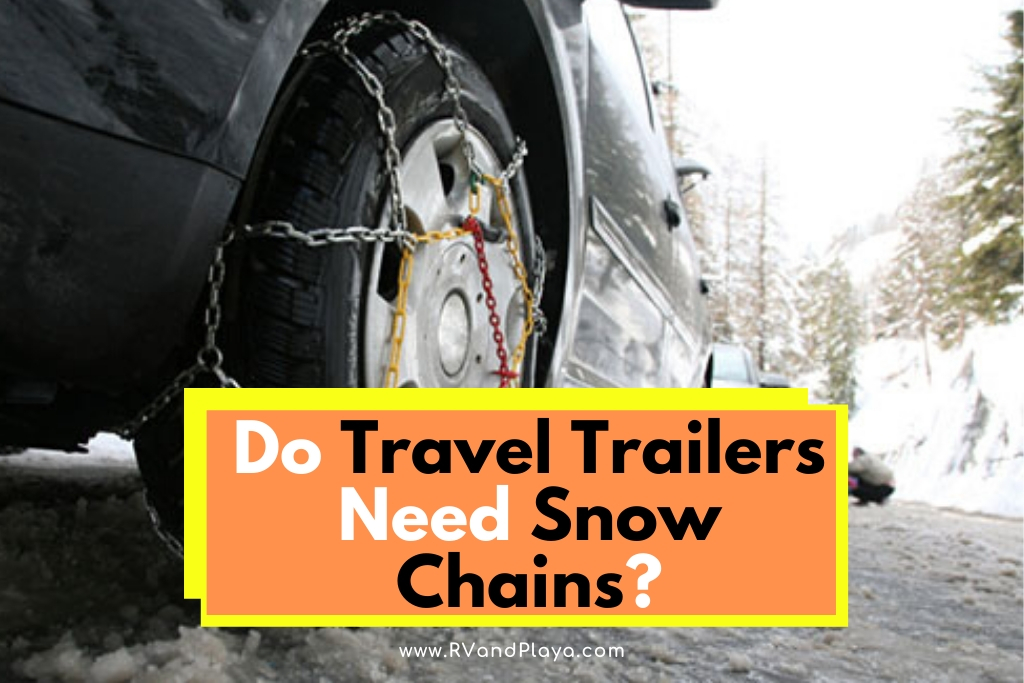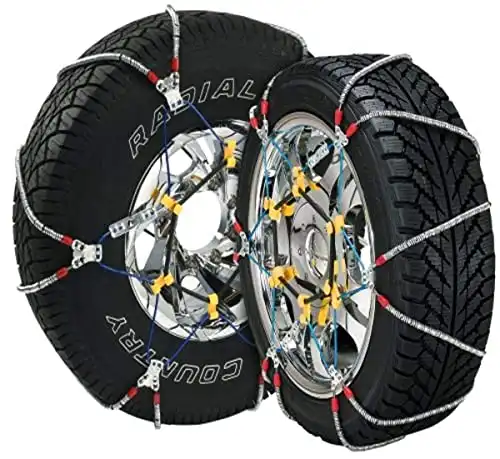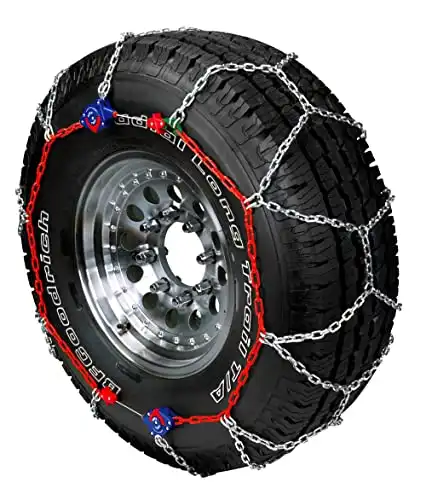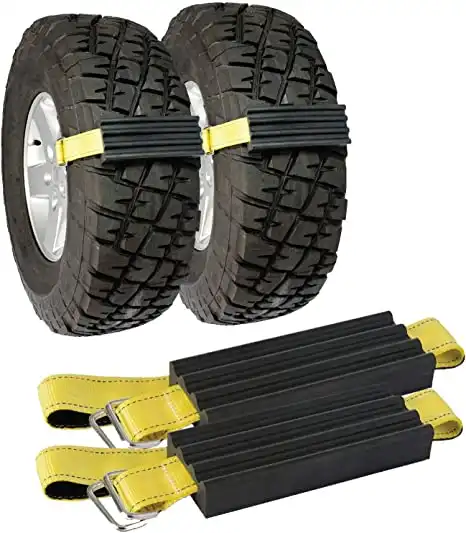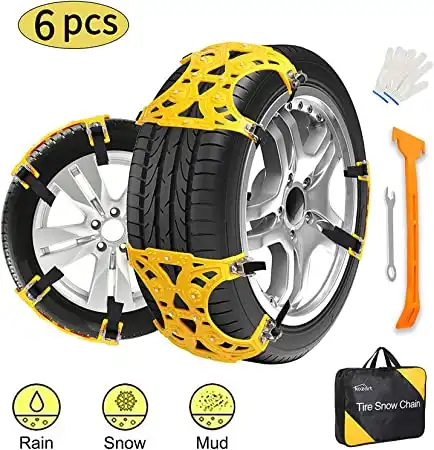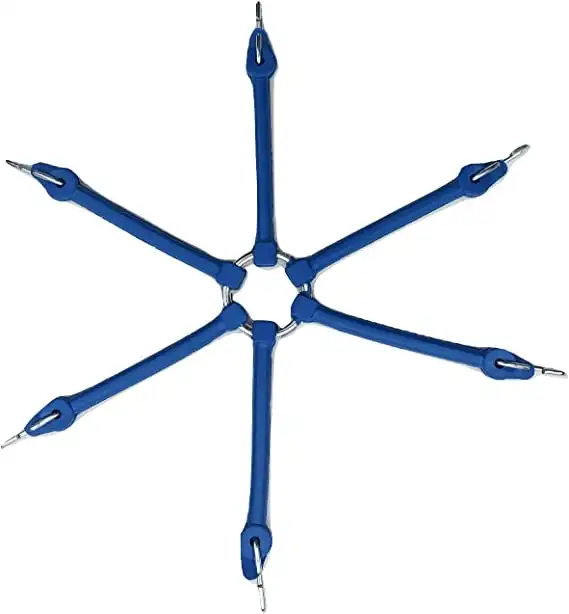When traveling in snowy or icy conditions via travel trailers, snow chains are often used to combat hazardous weather and threatening roads. As every driver longs for improved safety, I decided to research the legitimacy and necessity of this snow equipment; this article will explore whether or not your travel trailer needs snow chains.
Do travel trailers need snow chains? While there are numerous conditions and settings that dictate where and when to use snow chains, in order to maintain maximum safety for yourself and those around you, snow chains are a necessity for RVs.
Snow chains are widely used in snowy, icy regions of the world, and help to maintain traction between tires and the surface. Especially in travel trailers, understanding how and when to use them is paramount to avoiding road endangerment.
Table of Contents
When to Use Snow Chains on Travel Trailers
Tire chains should only be used during hazardous or wintery conditions; when used on pavement or surfaces not obstructed by snow or ice, snow chains can become harmful to both your vehicle and the road.
Referring to your vehicle’s manual can further clarify when to use snow chains on your RV.
Even with four-wheel drive and AWD vehicles, it is recommended that chains be used as a legal and precautionary measure.
Automobiles that function using front-wheel or rear-wheel drive systems also require tire chains to optimize safety and tire grip, although set-up differs between the two.
Click here for both front-wheel-drive and rear-wheel-drive configuration instructions.
How to Install Tire Chains Correctly >> Check out the video below.
Is it Legal?
The usage of snow tires or winter tires also does not take away the necessity for tire chains. While they may not be used at all times, many laws require the presence of chains in all vehicles, including RVs. On the other hand, in some regions, there are laws prohibiting the usage of snow chains.
Laws regarding the usage of snow chains vary among states; here is a thorough list explaining the policies of all fifty states plus U.S. territories.
Some states have seasonal restrictions dictating when the usage of snow chains is permitted, while other more extreme climates maintain authorization year-round. Especially when traveling long distances in an RV, staying updated with your region’s policies is essential to avoid legal issues.
Related reading: Do RV Parks Allow Travel Trailers? – Read This Before You Go
Removing Chains
When roads are plowed and/or salted, removing your chains from your vehicle must be done both with haste and precision to avoid unintended incidents. When you reach a region that no longer requires snow chains, safely pull over to the side of the road and remove them.
The following road conditions should not be driven on with tire chains:
- Plowed road
- Salted surfaces
- Dried surfaces
- Melted snow without any apparent snow or ice
This short video below explains in detail the proper protocol for removing snow chains.
How Many Chains Does My Travel Trailer Need?
For all travel trailers being driven in the snow, a minimum of four snow chains (one set on the trailer, one set on the vehicle pulling the trailer) is needed to improve traction and safety. If using a standalone travel trailer, a minimum of two chains (one set) should be used.
Travel trailers of all kinds benefit from tire chains due to the increased swaying caused by the excess trailing weight.
Weight Thresholds
In some states, the necessity of snow chains on travel trailers is mandated based on the weight of your vehicle. Since many travel trailers weigh an additional 3,000, up to 15,000 pounds on top of what the leading vehicle weighs, the presence of extra snow chains for some circumstances is required.
For example, in Washington, the state law requires “any commercial vehicle over 10,000 pounds” to use snow chains.
Elsewhere, California law requires a minimum of eight chains for a standard tractor-trailer configuration to comply with state-mandated regulations.
Source: ATBS.com
Picking the Right Chains
Snow chains come in a variety of sizes to meet the needs of many different tires. In order to properly select tire chains that fit your travel trailer, the most effective series of steps to complete is as follows:
- In the sidewalls of your tires, take note of a list of numbers and letters.
- Find the first three letters; these should be grouped together and may start with a “P”
- Locate the two numbers after the dash and before the “R”- include the “R”
- Identify the two numbers after the “R”
- On a sheet of paper or other material, write down these three numbers, separating them each by a slash.
- These numbers represent, in order, the width of the tire in mm, the ratio of tire width to height, and the size of the tire.
- An example of what your list of numbers and letters should look like is: 215/60R/16
Once you have your tire “code,” simply pay a visit to your regional auto supply store and give a staff member your tire information.
Source: Itstillruns.com
I have chains for both axles of my truck and one axle of the trailer. But when I travel in the snow, conditions can change quickly so be prepared. I use these link chains on my truck and the cable chains on the trailer.
? Purchase: You can purchase these tire snow chains today! Just follow the links to Amazon where you can see current pricing.
+ Fast easy installation with no need to move the vehicle
+ Designed-in rubber tightener means there is no need to stop and retighten after installation
+ Worry-free self-tightening ratchets provide automatic tightening and centering
+ Easy installation and removal in minutes.
+ Diamond pattern cross chain provides a smoother ride and superior traction
Picking the Right Material
The vast majority of snow chains are made up of either hardened steel, manganese nickel steel, or titanium. These materials all have their perks and drawbacks, although the main determining factor is how and where you drive your vehicle.
For most travel trailer drivers, opting for either hardened steel or manganese nickel steel is the way to go.
Hardened steel is more appropriate for the shorter-term user, one who is willing to replace their chains after a few years due to rust.
Manganese nickel steel is a level up from steel, with notably higher durability ratings attracting the user who withstands long winters year after year. The nickel chains are also lighter and combat rust.
At the top of the pyramid are titanium alloy chains. These are incredibly light, durable, and perhaps unsurprisingly, expensive. For the tundra person, a chain just as rugged and tough as they are.
Picking the Right Link
Similar to chain material, selecting the right link depends heavily on your personal purpose and preferences. The three main types of links sold are cables, twisted, and square.
Cable chains lean towards the quality of the ride over maximum traction and safety. Think of this section of chains as the sports car of snow chain links.
A median between relative extremes, twisted cables provide a healthy contrast between a solid, safe grip, and a smooth ride. Twisted cables are the Subaru SUV your mother encouraged you to drive instead of a sedan.
At the top of the safety food chain, resides square links– otherwise known as D links. Built for the worst that winter can throw at you, D links provide exceptional traction in snow and ice. You will not be driving fast, but you will be safe- a passenger van fits the bill.
For travel trailers, the best bet is to opt for D links or twisted cables.
Picking the Right Pattern
While there are four prominent patterns used on vehicular snow chains, there are two that stand out as the most suitable for travel trailers. The cream of the crop in chain patterns are the full pattern chain and the diamond pattern.
Born out of a combination between the ladder pattern and the V pattern, the diamond pattern lives up to its name as valuable in both traction and braking.
Another aspect of tire chains that falls into the category of “extreme” is the full pattern. Filled with traction along the entirety of the tire, tires with the full pattern are clunky, bumpy, and outrageously safe. This pattern is also marketed towards large vehicles like trucks.
For large travel trailers, the full pattern is the most sensible choice.
Source: The Chicago Tribune
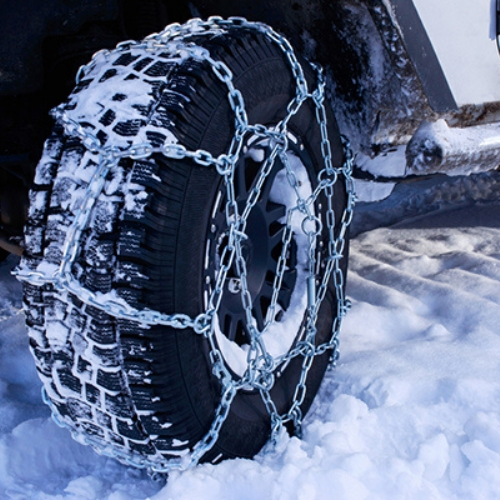
Leaving a Trail
In a world where the number of people on the road is growing with no definitive cap, safety should be at the first thought for drivers of travel trailers.
The widespread usage of snow chains offers a supplementary piece to the puzzle of managing hazardous driving conditions and reducing automobile accidents.
In order to do your part in maintaining travel trailer safety, snow chains are a must in snowy conditions, for yourself as well as those around you.
You might also like
+ GET UNSTUCK WITH TRAC-GRABBER - a quick, simple and effective solution when your vehicle is stranded in all types of terrain and adverse weather conditions.
+ Fast easy installation with no need to move the vehicle, Snow tire chains can be installed by one person,
+ Professional x-large Tire Chains Plier for 3/8 inch and larger tire chains.
+ 33.5" long for large tractor and Heavy Duty tire chains.
+ Helps keeps chains tight increasing life of chain up to 30% longer.
+ Keeps the tire chains tight and in place
Recent Posts
Is Toyota Remote Connect Free? (Subscription, Services Plans)
Does Toyota Remote Connect have an included trial? It used to be the case that, when you bought a new car, you made one straightforward payment and that was it. Now, it feels like there are...
Toyota Safety Connect: What It Is And Why You Need It? Whether you’re buying a new Toyota or you’ve had one for a while you will have been given the hard sell on their Connected Services but do...

